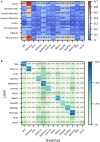Self-supervised pretraining improves the performance of classification of task functional magnetic resonance imaging
- PMID: 37434766
- PMCID: PMC10330812
- DOI: 10.3389/fnins.2023.1199312
Self-supervised pretraining improves the performance of classification of task functional magnetic resonance imaging
Abstract
Introduction: Decoding brain activities is one of the most popular topics in neuroscience in recent years. And deep learning has shown high performance in fMRI data classification and regression, but its requirement for large amounts of data conflicts with the high cost of acquiring fMRI data.
Methods: In this study, we propose an end-to-end temporal contrastive self-supervised learning algorithm, which learns internal spatiotemporal patterns within fMRI and allows the model to transfer learning to datasets of small size. For a given fMRI signal, we segmented it into three sections: the beginning, middle, and end. We then utilized contrastive learning by taking the end-middle (i.e., neighboring) pair as the positive pair, and the beginning-end (i.e., distant) pair as the negative pair.
Results: We pretrained the model on 5 out of 7 tasks from the Human Connectome Project (HCP) and applied it in a downstream classification of the remaining two tasks. The pretrained model converged on data from 12 subjects, while a randomly initialized model required 100 subjects. We then transferred the pretrained model to a dataset containing unpreprocessed whole-brain fMRI from 30 participants, achieving an accuracy of 80.2 ± 4.7%, while the randomly initialized model failed to converge. We further validated the model's performance on the Multiple Domain Task Dataset (MDTB), which contains fMRI data of 26 tasks from 24 participants. Thirteen tasks of fMRI were selected as inputs, and the results showed that the pre-trained model succeeded in classifying 11 of the 13 tasks. When using the 7 brain networks as input, variations of the performance were observed, with the visual network performed as well as whole brain inputs, while the limbic network almost failed in all 13 tasks.
Discussion: Our results demonstrated the potential of self-supervised learning for fMRI analysis with small datasets and unpreprocessed data, and for analysis of the correlation between regional fMRI activity and cognitive tasks.
Keywords: brain networks; deep learning; fMRI; interpretability; self-supervised.
Copyright © 2023 Shi, Wang, Wu, Chen, Hu, Zhang, Qiu and Wang.
Conflict of interest statement
The authors declare that the research was conducted in the absence of any commercial or financial relationships that could be construed as a potential conflict of interest.
Figures





Similar articles
-
Brain decoding of the Human Connectome Project tasks in a dense individual fMRI dataset.Neuroimage. 2023 Dec 1;283:120395. doi: 10.1016/j.neuroimage.2023.120395. Epub 2023 Oct 12. Neuroimage. 2023. PMID: 37832707
-
Volumetric white matter tract segmentation with nested self-supervised learning using sequential pretext tasks.Med Image Anal. 2021 Aug;72:102094. doi: 10.1016/j.media.2021.102094. Epub 2021 Apr 30. Med Image Anal. 2021. PMID: 34004493
-
A semi-supervised classification RBM with an improved fMRI representation algorithm.Comput Methods Programs Biomed. 2022 Jul;222:106960. doi: 10.1016/j.cmpb.2022.106960. Epub 2022 Jun 17. Comput Methods Programs Biomed. 2022. PMID: 35753106
-
A survey of the impact of self-supervised pretraining for diagnostic tasks in medical X-ray, CT, MRI, and ultrasound.BMC Med Imaging. 2024 Apr 6;24(1):79. doi: 10.1186/s12880-024-01253-0. BMC Med Imaging. 2024. PMID: 38580932 Free PMC article. Review.
-
Spatio-temporal modeling of connectome-scale brain network interactions via time-evolving graphs.Neuroimage. 2018 Oct 15;180(Pt B):350-369. doi: 10.1016/j.neuroimage.2017.10.067. Epub 2017 Nov 10. Neuroimage. 2018. PMID: 29102809 Free PMC article. Review.
Cited by
-
Strategies to Improve the Robustness and Generalizability of Deep Learning Segmentation and Classification in Neuroimaging.BioMedInformatics. 2025 Jun;5(2):20. doi: 10.3390/biomedinformatics5020020. Epub 2025 Apr 14. BioMedInformatics. 2025. PMID: 40271381 Free PMC article.
References
-
- Aben B., Calderon C. B., Bussche E. V., Verguts T. (2022). Task-dependent effort-induced connectivity. OpenNeuro.
-
- Akbari H., Yuan L., Qian R., Chuang W.-H., Chang S.-F., Cui Y., et al. . (2021). Vatt: transformers for multimodal self-supervised learning from raw video, audio and text. Adv. Neural Inf. Proces. Syst. 34, 24206–24221.
-
- Alwassel H., Mahajan D., Korbar B., Torresani L., Ghanem B., Tran D. (2020). Self-supervised learning by cross-modal audio-video clustering. Adv. Neural Inf. Proces. Syst. 33, 9758–9770.
-
- Bandettini P. A. (2020). Fmri Cambridge, MA: MIT Press
LinkOut - more resources
Full Text Sources
Miscellaneous

